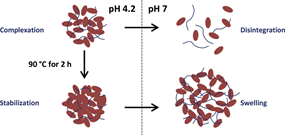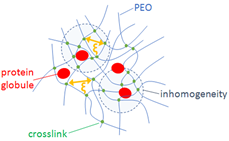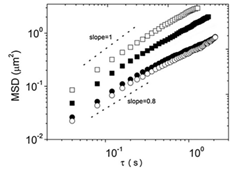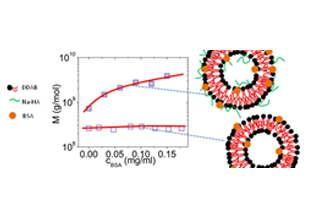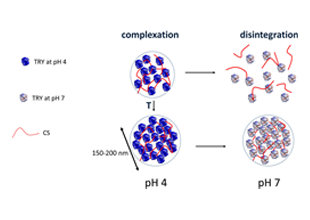Αναζήτηση
ΚΛΕΙΣΙΜΟΑνάπτυξη νανοδομημένων βιοϋλικών
Δρ. Αριστείδης Παπαγιαννόπουλος
- Ανάπτυξη νανοδομημένων βιοϋλικών
- Προχωρημένος φυσικοχημικός χαρακτηρισμός και βελτιστοποίηση
Nanostructured biomaterials are designed and prepared mainly by biocompatible methodologies using biocompatible components and utilizing the ability of the building blocks to self- and co- assemble under certain conditions. Different arrangements at the nanoscale can be obtained that lead to a broad range of materials which include nanoparticles, thin films, hydrogels and complex fluids. The resulting multifunctional materials can interact with and regulate the encapsulation, release and diffusion of bioactive molecules.
Novel biomaterials by co-assembly of biopolymers including polysaccharides and proteins are developed without the use of chemical reactions or toxic solvents. Protein-polysaccharide nanoformulations are prepared by optimizing the solution conditions and composition to obtain electrostatic protein/polysaccharide complexes of monodisperse size distribution in the range 100-200 nm. Proteins as building blocks introduce multifunctionality to the nanoformulations. The nanoparticles are stabilized against pH changes by thermal denaturation of the proteins. These nanostructures have the ability to encapsulate and preserve the structure of bioactive substances such as β-carotene and curcumin.
Hydrogels are synthesized by chemical crosslinking of biocompatible polymers, ionic crosslinking between oppositely charged polysaccharides and complexation between polysaccharides and proteins. These biomaterials are able to sustainably release proteins and drugs as their internal characteristic correlation length is in the order of several nm. Self-assembly and co-assembly organization is also used to modify the rheological properties of complex fluids. The rigid helical natural polyelectrolyte xanthan creates self-similar soft hydrogels whose dynamic and structural properties can be effectively modified by the use of surfactants. These fluids are investigated with the aim to develop novel dermal delivery formulations with tunable properties.
Polyelectrolyte multilayers between biopolymers and proteins are developed for cell proliferation and tissue engineering applications. The layer-by-layer deposition method is used to modify the hydrophilicity of the adsorbed layers and incorporate proteins such as fibrinogen which is an effective agent for wound healing and tissue growth. These films are biocompatible and reusable, have outstanding performance in cell culture and can be used for tissue engineering and regeneration applications. Polysaccharides have been also used to modify the interface of model vesicles in order to tune the interactions and adsorption of proteins.
Key Publications
- Ανάπτυξη νανοδομημένων βιοϋλικών
- Προχωρημένος φυσικοχημικός χαρακτηρισμός και βελτιστοποίηση

